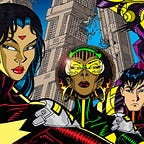DRACONIAN PROCESS no.5
Here on page five of the New Draconians, the widescreen approach is reinforced with a conscious choice in design. I’ve written before how there is one school of approach to western comic book storytelling where the eye should visually go from the upper left and work it’s way down and out through the bottom right of the last panel.
Panels one and two are thematically connected and subtly direct the reader’s eye downward. The perspective through line used to illustrate the futuristic Manhattan cityscape works in tandem with design lines of the interior background of the second panel. Using a color hold on the panel two background serves to reinforce this theme with the foreground in complete silhouette, which in turn does double duty. First it gives the illustration added depth and secondly it acts as a frame of sorts for the Techno-path drone pilot.
The Techno-path drone pilot in the foreground of the third panel is the focal point of the page. The prominence, detail, and color outline reinforces this. Meanwhile, with the secondary pilot I chose to use color to both accentuate and add depth. Through the use of different color layers, reducing the opacity and utilizing a blue overlay I recede the second figure into the background.
Erasing the overlay from key light sources emitting from the second pilot and his chair allowed those light sources to really glow and stand out. This illustrates having your cake and eating it too. Just because the Techno-path pilot is in the foreground doesn’t mean I can’t make the background figure any less dramatic. Especially since the viewer sees him manipulating various light hologram computer displays which propels the story forward.
Which brings us to the final panel, and again it’s an illustration that benefits from color and special effects. First I colored the ramjet in the foreground at one hundred percent opacity. Then I colored the incoming drones in another layer with reduced brightness followed by a photograph of Earth as the third layer. Again, I used the blur tool on the Earth ever so slightly to invoke speed.
In addition, the placement of the ramjet itself in relation to the figure in the third panel moves the viewer’s eye down and out. I wish my storytelling was always this straightforward and simple.
Even lettering can assist in this regard. It’s no accident that I chose a lettering configuration that assists with moving the eye from upper left and diagonally descends downward mirroring the action on the page. In MOST instances lettering is the easiest part of the page for me. Perhaps it’s the psychological signifier that the page is almost complete… or that once the lettering is added it somehow makes the comic page REAL.
Authentic.
Whatever the reason, this is a stage I love. Usually. They’ll be other times when lettering isn’t so effortless. Thankfully, this isn’t one of those pages. The influences of my lettering literally run the gamut from all over the world. In America, two letterers always stood out head and shoulders above all the rest. Tom Orzechowski, and John Workman.
Tom Orzechowski is the unsung hero of the X-MEN. He took the prose of Chris Claremont and made it concise and legible. He merged word and picture, regardless of artist. Whether that artist was Dave Cockrum, John Byrne, Paul Smith or a host of others that would follow… Tom Orzechowski remained the consistent gold standard letterer.
And he made it look easy.
Once upon a time a writer and artist by the name of Walter Simonson took over the Mighty Thor. His art was loud, bombastic, stylized and graphic. He was smart enough to find a letterer that exemplified those qualities and enhanced his work. John Workman’s lettering style stood head and shoulders above his contemporaries. Beyond his unmistakable sound effects was his signature circular word balloons. Circular word balloons with a significant amount of negative space between the copy and balloon that complimented the over the top illustrations of Simonson perfectly.
I was like, “Oh damn. If I ever letter something… I’m doing it like THAT”.
However, influences weren’t done with me. Japanese manga always had and continues to have a strong sway over my work. A large component of that style permeated through lettering placement. Here’s where east meets west. The overall “house style” in many ways reinforced what I was seeing directly from Workman. Still very much in love with how Dan Nakrosis adapted Kia Asamiya’s Batman: Child of Dreams.
The last piece of the puzzle is simplicity. Let’s strip the design down to its most basic components. European comics in many cases dispensed with outlines around the word balloons completely. Letting the white negative space of the balloon counter the usually very dense, sometimes almost photorealistic colored illustrations. Those types of balloons allowed the viewer’s eyes to not to be overwhelmed with so much visual information. Lesson learned and an aspect I would include in my toolbox moving forward.
Well that’s enough rambling for this time…
Want to see the finished product and how the story is progressing? By all means check out THE NEW DRACONIANS on Tumblr:
http://newdraconians.tumblr.com/
And if you can, please support my efforts on Patreon, I’d greatly appreciate it!
